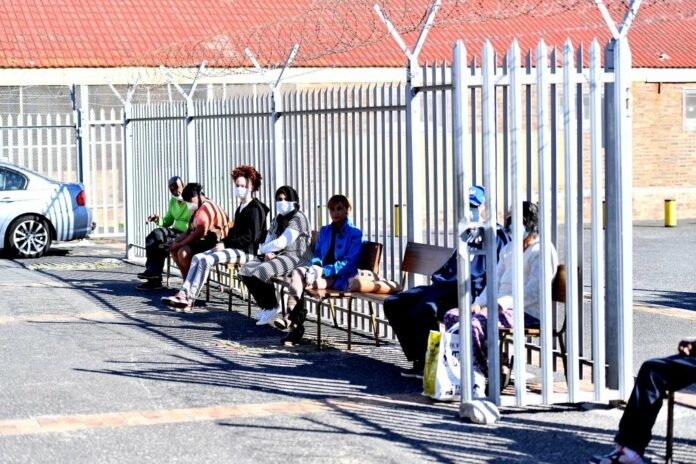Health workers screen for Covid-19 at Westridge Community Health Centre in Mitchells Plain. (Photo by Ashley Vlotman/Gallo Images via Getty Images)
A doctor on the front line of the Covid-19 war, writes anonymously from a community health centre on the Cape Flats.
The patient arrived at 15:00. “I can’t breathe.”
It was a public holiday. One doctor was attending to a run of gunshot wounds in the non-Covid emergency centre. A second young doctor was left in the “flu” clinic with dozens of possible Covid patients, most of them mild. A cough. A sore throat. No taste. Most of them fine.
“I can’t breathe.” An elderly gentleman was dropped off by his family at 15:00. No, they cannot come in; there’s a virus. Short of breath, sugar high. He didn’t remember his phone number. The nurse put him on oxygen and gave him insulin. She booked an ambulance for the hospital, helped him lie down on an examination bed in the consultation room turned temporary Covid ward and gave him a sheet. It’s all they had.
Thirty more people came that day. I need a medical certificate for work. I was here three weeks ago and my boss won’t pay me without proof. One doctor, alone. Fully gowned with a mask and visor, hot. Speaking to people briefly but not too close. The patients come in and wait. They carry their own plastic chair from the waiting room to the examining room so as not to infect each other. You never know who is positive. No, stay there.
The doctor sits on one side of the room and the patient on the other. Fear. Quick. No shortness of breath? Good. Oxygen level normal. Stay home. Over and over again. A reverberating monotony of physically distanced patients, most of them well, but fear lurking behind every encounter. Patients fear they might die. Doctor’s fear they might be exposed. There’s no time to tell the usual stories (“How are you?”). Are you stable? Good. Stay home. Take some Panado. Isolate.
“I can’t breathe.”
At 07:00 the next day, the gentleman is still lying on the bed waiting. The nurse checks on him. “Are you okay?” “Yes.” Waiting. Alone. Twenty new patients walk in. Oxygen okay, sick certificate, home. Oxygen okay, sick certificate, home. Amidst the coughs, a group of 10 healthy people are sent from work because they were exposed. More paperwork. If you’re well, go home. We’ve been told to quarantine people away from home, but nobody wants to go (“Alone?”).
Oxygen okay, sick certificate, home. Oxygen LOW. Shockingly low. Is this real? This woman was here a week ago and now she’s back. “I can’t breathe.” As her ribs heave in and out, we put her on a face mask and wait. Ten litres per minute of oxygen, it’s all we have. Six people on oxygen, and hopefully no more. We’re full. They said they ordered more oxygen gauges. They said we must follow the proper channels. They said.
“I can’t breathe.” At 11:00 the ambulance still hasn’t arrived. They said there would be delays. They said we should expect to hold patients 24 to 48 hours, we cannot help it. There aren’t enough ambulances. We need to transfer patients from hospitals to the convention centre to clear high-care bed space.
We have all seen pictures of the president shaking hands with the premier at the quickly constructed field hospital, 850 shiny new beds for Covid patients waiting to be filled. Other pictures of an ambassador donating ventilators to the glorious hospital on the hill. But there are no pictures of the community health centre at 11:00, 20 hours later.
“Are you okay, meneer?” “Yes.” Alone on an examination bed, he waited without complaint. “How are we going to feed people?” we asked. “Are we going to have extra nursing staff to monitor patients?” we asked. “We are not a hospital.” We said. “We’ll get back to you.” They said.
“I can’t breathe.”
More coughs. More colds. More dead bodies, more than usual. Brought in by the undertakers. And 70-year-old diabetics suddenly dying at home. “Natural causes.” (Is this real?) Death certificates intermixed with medical certificates for the torrent of masked faces marching one by one with new plastic chairs.
People are marching around the world. “I can’t breathe.” Brown people. Black people are dying. More than others. And it’s not fair. It’s not fair that the hospital on the hill has the beds and the food and the ambulances while the community waits at the edges, trapped in the flats with no way out. “I can’t breathe.”
12:00. The ambulance arrived. Finally. “Meneer, they’re here. Meneer?” He lay gently on the examination table, silently alone. No number to phone. His daughter came 15:00. “What happened to my father? I can’t see him?”
The vuvuzela sounds at 20:00. “Forget ventilators, just give us an ambulance. Or even a taxi to get these patients to hospital.”
“I can’t breathe.”
There are no heroes in community health centres. Just tired doctors and nurses waiting for help. And mountains of quiet paperwork, for the living and the dead.
– The author works in a community health centre in Cape Town.
